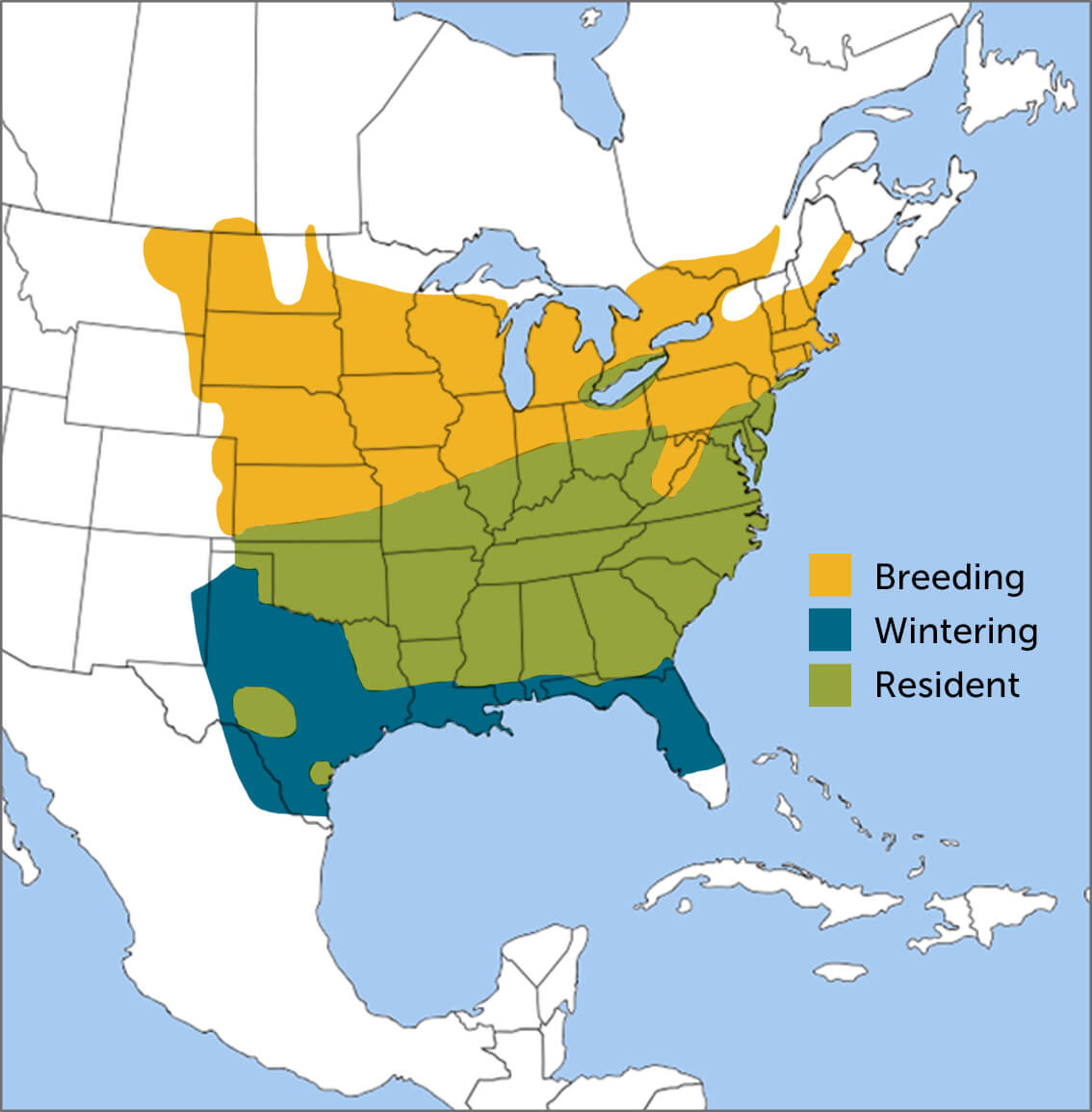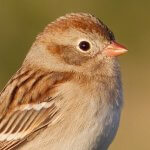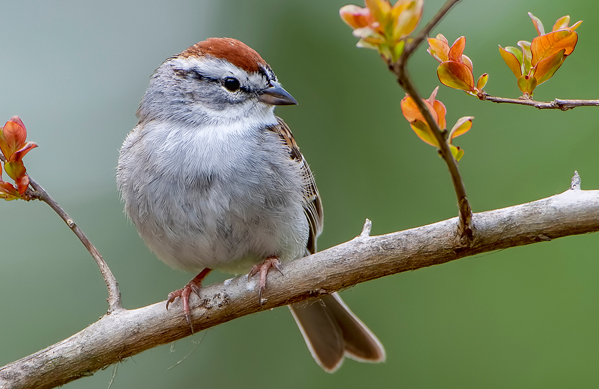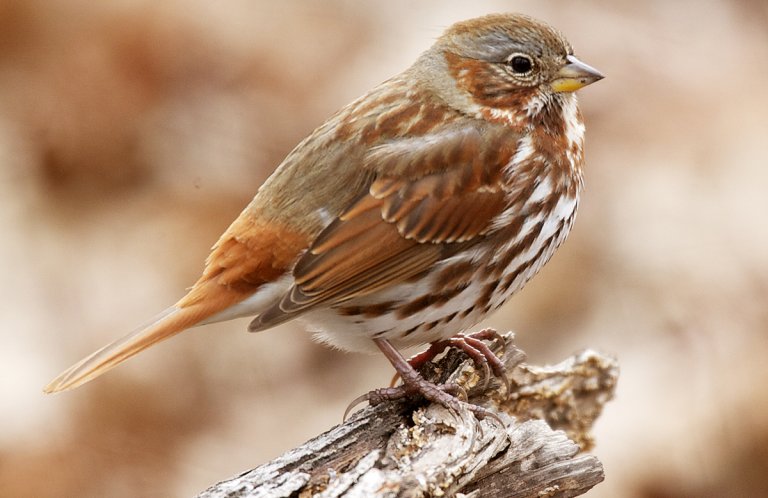About the Field Sparrow
The Field Sparrow's trilling song is a common summer sound, and this pretty little bird is often heard before it is seen. Patient observers can track the song to its source: a small, pink-billed sparrow with a bold white eye ring, often skulking in a thick shrub or small tree. These particular field marks distinguish it from other small sparrows that may share its habitat, such as the Chipping Sparrow.
Other Field Sparrow characteristics include an unstreaked pale-gray chest and face, a rusty-brown streak behind the eye, and a reddish cap. Juveniles have narrow dusky streaking on the chest, sides, and crown. The sexes look alike.
Like other ground-nesting species such as the Northern Bobwhite and Eastern Meadowlark, the Field Sparrow is especially vulnerable to predation of its eggs and young.
Nesting on the Up and Up
The female Field Sparrow usually builds her first nest of the season on the ground, hidden in grasses at the base of a shrub or other woody plant. Such sites are vulnerable, however, and predators such as snakes often destroy these initial nesting attempts. The Field Sparrow adapts by re-nesting, building her nest higher off the ground with each attempt as the ground cover and woody plants grow taller during the season. This persistent sparrow may nest up to five times per breeding season!
Songs and Sounds
The best way to find a Field Sparrow is to listen for its distinctive accelerating song, which is often compared to the bouncing of a ping-pong ball on a table.
Listen to its sweet, speedy trill here:
Breeding and Feeding
Male Field Sparrows tend to return to the same breeding territory each year. Each male aggressively defends a small territory, singing persistently until he attracts a mate. The mated pair remains together for the duration of the breeding season, then joins up with small flocks for the winter.
The female Field Sparrow builds an open cup nest of grasses, with her mate sometimes contributing material to the process. A typical Field Sparrow clutch size is 3-5 eggs, which the female broods for approximately a week and a half. After hatching, both parents feed the young. They fledge in about a week, but stick close to their parents for about another month.

The Field Sparrow is a frequent host to the Brown-Headed Cowbird, which further reduces its nesting success; the larger cowbird hatchlings outcompete the Field Sparrow chicks, which die of starvation or are pushed out of the nest.
Adult Field Sparrows, like Fox Sparrow or Ruffed Grouse, will use a broken-wing display to distract predators from their nest.
Field Sparrow Fare
Like other sparrows, the Field Sparrow consumes a seed-based diet, foraging on the ground under or near cover. Its small bill confines it to smaller grass seeds, which it obtains by climbing stems or picking them up from the ground. During the breeding season, Field Sparrows add more protein to its diet, eating insects and spiders and feeding young caterpillars, grasshoppers, and other small insects.
Region and Range

Not a fan of suburban areas, the Field Sparrow prefers brushy, early-successional fields, shrubby meadows, and forest openings and edges, which it shares with species such as White-eyed Vireo, Blue-winged Warbler, and Yellow-breasted Chat. It winters in similar habitats.
The Field Sparrow's breeding range covers the eastern United States and Canada, and it winters as far south as northeastern Mexico. Many populations are resident (non-migratory); but northern populations move south each fall, making the species a partial, or short-distance, migrant.
During the winter, Field Sparrows form mixed flocks with other species, including White-throated and Song Sparrows.
Conservation

Help support ABC's conservation mission!
Although still a fairly common species, the Field Sparrow has been declining, partly because of habitat loss caused by suburban expansion. Partners In Flight classifies the Field Sparrow as a “Common Species in Steep Decline.” Species in this category — which range from grassland birds such as the Horned Lark to forest dwellers such as the Blackpoll Warbler – have lost from 50-90 percent of their populations since 1970. Most are projected to lose another 50 percent within the next 20-25 years.
The Field Sparrow benefits from ABC's work to create early successional habitat for species such as the Golden-winged Warbler and American Woodcock. With partners, ABC is restoring habitat through forest management in Wisconsin, Michigan, Minnesota, Pennsylvania, Maryland, Tennessee, and North Carolina.
Get Involved
Policies enacted by the U.S. Congress and federal agencies, such as the U.S. Fish and Wildlife Service, have a huge impact on U.S. birds. You can help shape these rules for the better by telling lawmakers to prioritize birds, bird habitat, and bird-friendly measures. To get started, visit ABC's Action Center.
Living a bird-friendly life can have an immediate impact on the birds around you. Doing so can be as easy as adding native plants to your garden, avoiding pesticides, and keeping cats indoors. To learn more, visit our Bird-Friendly Life page.
American Bird Conservancy and our Migratory Bird Joint Venture partners have improved conservation management on more than 8.5 million acres of U.S. bird habitat — an area larger than the state of Maryland — over the last ten years. This is a monumental undertaking, requiring the support of many, and you can help by making a gift today.






















































